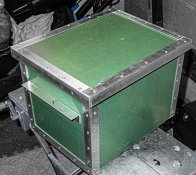Why not just keep the paper in the original dark-bag until ready to use? Then all you need to hold the roll is a stand to hold a horizontal bar (through the paper roll's core). The stand could be a wood base plate with an upright arm at each end. If you cut a "V" notch at the top of each upright this will keep the horizontal bar in place. (If the bar is relatively short you might want a collar of sorts so it can't fall out of the v-notch.)
You'd wanna cut what you need for a printing session, then PUT YOUR LONG ROLL BACK IN THE DARK-BAG. Otherwise it's way too easy to forget about it and turn on the room lights (this will put edge fog on the entire roll). I've seen probably hundreds of rolls like this over the years; the fog typically only goes in about 1/16 inch or so, but that's enough that you can't print to the spec size anymore. (In photofinishing, such rolls would be relegated to color tests, so no real loss, but if it's your only roll...)
Don't let the emulsion side touch your bench, and when you cut the paper you might want to hold it down with either a gloved hand, or perhaps lay a piece of scrap paper on top so that your finger don't touch the emulsion.
As a note, something we did long ago in our processor darkrooms, back when a long-roll paper processor was built half-in and half-out of a darkroom, was to replace the light switches with those key-operated switches (they have a little bar inset, and a little forked "key" was used like a lever to operate the switch). Just the slight delay of having to reach in your pocket was typically long enough for your brain to register, oh, did I leave the paper roll out?





 Paper roll on the left (ironing board pushed up against the wall so the paper can't fall on the floor), rotary cutter next in line and a 16" inch stick taped to the ironing board to measure the length. I cut the paper a bit longer than required so I can trim it straight after the print has dried. Works fine for 20 or so sheets, but I wouldn't want to do much more than that. The paper I have is emulsion side out, but I've never had any issues with it marking. I do wear cotton gloves while I'm cutting the paper which probably helps.
Paper roll on the left (ironing board pushed up against the wall so the paper can't fall on the floor), rotary cutter next in line and a 16" inch stick taped to the ironing board to measure the length. I cut the paper a bit longer than required so I can trim it straight after the print has dried. Works fine for 20 or so sheets, but I wouldn't want to do much more than that. The paper I have is emulsion side out, but I've never had any issues with it marking. I do wear cotton gloves while I'm cutting the paper which probably helps.